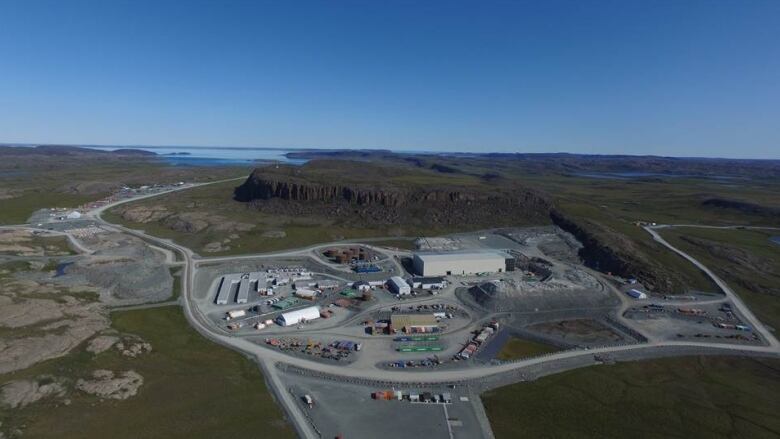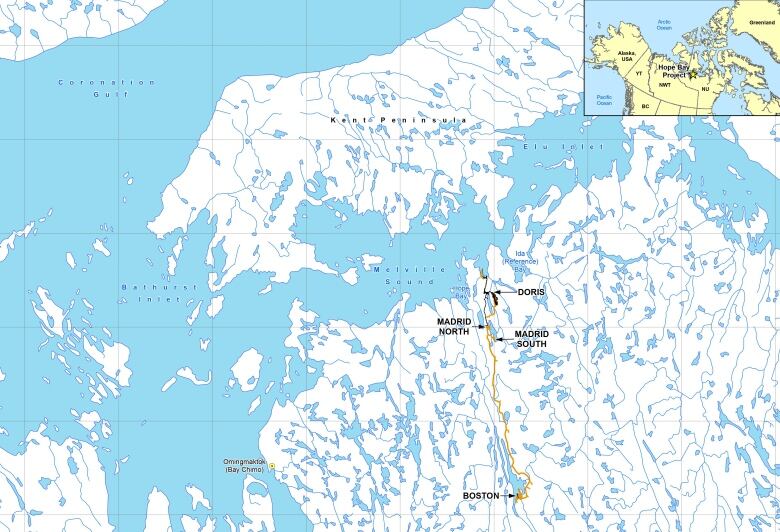Chinese company makes agreement to buy Nunavut gold mine
TMAC Resources arranges to sell Hope Bay project to Chinese-government owned company

The company behind an ongoing gold project in Nunavut's Kitikmeot region, is all set to be sold to a Chinese mining company.
TMAC Resources owns the Hope Bay gold mine project, located 125 kilometres southwest of Cambridge Bay.
On May 8, the company announced a "definitive agreement" to sell to Shandong Gold Mining, a state-owned Chinese mining company, for around $230 million.
The deal values TMAC at $1.75 per share a 52 per cent premium on the share's average price, according to the announcement, and about 30 cents more per share than its listed price before the announcement.
The sale must be approved by two-thirds of the company's shareholders. TMAC is also hoping to get the approval of the Kitikmeot Inuit Association (KIA), the land claim organization representing the region's Inuit, which owns one per cent of shares.
Though a statement accompanying the announcement voiced tentative support for the agreement, it also made clear the organization hasn't decided yet if it will support the sale.

TMAC would not comment on the sale until it was complete. Shandong Gold did not respond to requests for comment.
"We have been impressed by TMAC's strong relationships with its local stakeholders and responsible management and intend on demonstrating the same commitment," reads a statement attributed to Chen Yumin, chairman of Shandong Gold, accompanying the announcement of the sale.
That release says the company will maintaintargets for Inuit employment and royalty payments to the territorial and regional Inuit organizations, established in an impact benefit agreement between TMAC and KIA.
They also pledged to continue contracting with local andInuit-owned firms. Those contracts were valued at more than $68 million last year, according to filings from TMAC.
An expensive prospect
The sale would bring to an end TMAC's eight years in charge of the Hope Bay property.
The area's gold deposits, which could eventually produce nearly 150,000 kilograms of gold, have been owned by three different mining companies since they were first identified more than 30 years ago.
In 2012, TMAC acquired it from Canadian mining giant Newmont Mining and, three years later, signed a 20-year land tenure agreement with the KIA and the territorial Inuit land claim organization Nunavut Tunngavik Inc.
The property produced no gold for commercial sale until 2017, and in the time since its purchase, TMAC has poured more than $450 million into developing the deposits.
It's likely to need a lot more investment. A "pre-feasibility study" published last March explored the possibility of more than doubling its output of ore, estimating the cost of expanding operations at more than $683 million.
"Hope Bay requires substantial investment to optimize production and extend mine life," Chen's statement acknowledges.

But Shendong Gold "has the financial strength, technical capability and long-term vision to maximize the value of the Hope Bay camp," a statement from Jason Neal, the president and chief executive officer of TMAC, reads.
That value could extend beyond shareholders' pockets. Gold, whichgenerated nearly $900 million in revenues in Nunavutlast year, is the single biggest contributor to mining revenues and royalties for Inuit associations.
The mine at Hope Bay is expected to produce as much as $400 million in royalties alone over its lifetime for KIA and Nunavut TunngavikInc.
Those benefits have not always trickled down to communities. In 2018, TMAC fell short of modest goals for Inuit employment, failing to fill the equivalent of 70 full time positions, and was forced to pay a $90,700 fine as a result, filings with the Nunavut Impact Review Board show.
What is Shandong Gold Mining?
Shandong Gold Mining is a state-owned Chinese gold mining company, centred in the eastern province of Shandong. It's the second-largest producer of gold in China by output, and the latest of several to expand its operations overseas.
That expansion has been far from simple.
In its sole international venture to date, Shandong Gold purchased a 50 per cent interest in Canadian company Barrick Gold's Veladero Mine in Argentina, to the tune of more than $1.3 billion.
The mine is proving to be the most expensive per ounce of gold produced in Barrick's large portfolio.

It's also been the site of several controversial spills, including the biggest mining accident in Argentinian history, when one million litres of cyanide solution was spilled in 2015, two years before Shandong Gold came on board.
The day after Shandong Gold's purchase, the Argentine government threatened to rescind its license over a third cyanide spill inside 18 months, and workers at the camp went on strike over safety.
Argentinian regulators have since been satisfied that the safety situation has improved but workers at the camp continue to describe conditions there as "intolerable."
Those early difficulties haven't dented the company's ambition. At the opening of their Toronto office in 2019, amid rising diplomatic tensions between China and Canada, Shandong Gold chairman Chen Yumin said he hoped the company would become one of the top 10 gold producers in the world.
That would have benefits for Toronto's employment numbers, at least the May 8 announcement also pledged to make the city the headquarters for its North and South American operations.
Clarifications
- An earlier version of this story said a statement from the Kitikmeot Inuit Association was made to CBC News. In fact, it was made in a N.W.T. and Nunavut Chamber of Mines newsletter.May 21, 2020 8:10 AM CT
Corrections
- A previous version of this story said the Kitikmeot Inuit Association (KIA) must approve of the sale for it to proceed. In fact, the sale may proceed with or without the approval of KIA.May 20, 2020 12:27 PM CT












_(720p).jpg)


 OFFICIAL HD MUSIC VIDEO.jpg)
.jpg)



























































































